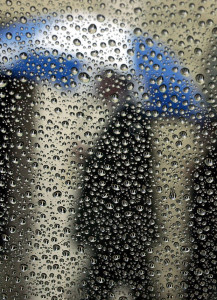
Raindrops form when microscopic water droplets bump into each other in clouds. The more turbulent the clouds, the bigger the raindrops get.
To explain how this process works, let’s consider water droplets in the upward-moving air of a cloud. Water droplets in clouds with different sizes move at different speeds, as gravity and vertical motions within the cloud act on the particles. The difference in speed increases the chance of collisions, just as the combination of fast trucks and slow cars increases the chance of collisions on a highway. Turbulent motions in the cloud can also cause the droplets to collide.
The process of combining cloud droplets through collision-coalescence is an important mechanism for forming precipitation in clouds composed solely of liquid water droplets.
Aggregation is the process by which ice crystals collide and form a single larger ice particle. In the summer, the collections of crystals may form in the cloud but then melt as they fall to the ground, forming rain. When an ice crystal falls through a cloud, it may collide with and collect supercooled water droplets. This process is called accretion and is a mechanism to quickly form large particles.
How big a droplet or crystal grows depends on how long it stays in the cloud. The longer a particle is in the cloud, the more particles it can collect and the larger it grows. The strength of the vertical motions and the thickness of the cloud determine how long it stays in the cloud. This is why only tall clouds with strong updrafts, such as thunderstorms, produce large precipitation particles.

